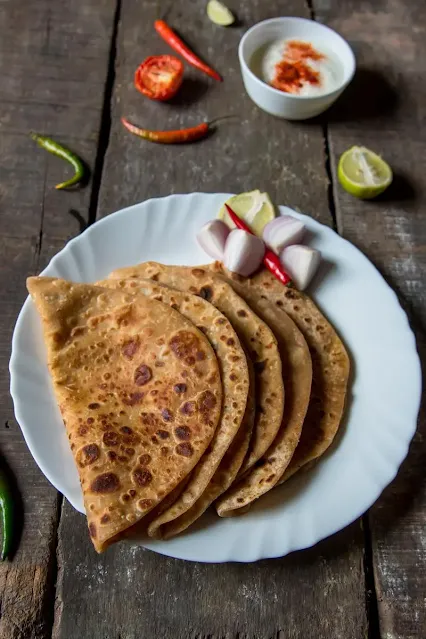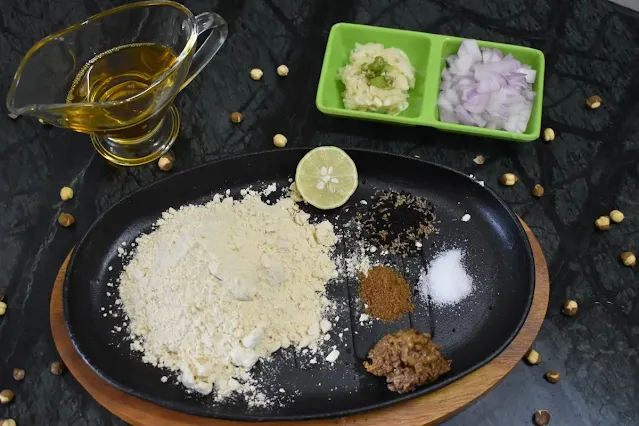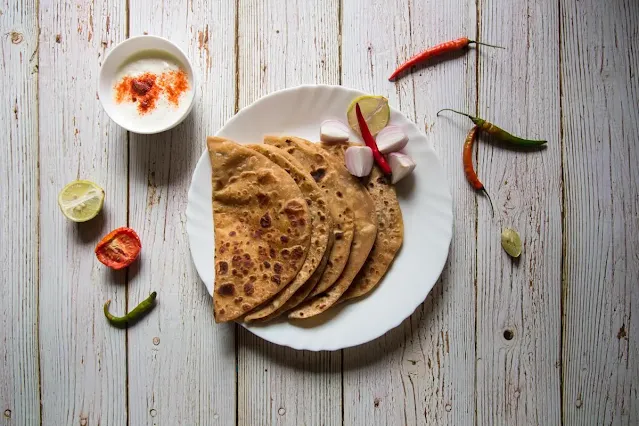Introduction:
Hello, fellow food enthusiasts! Today, I am excited to share with you a recipe that holds a special place in my heart and my kitchen - Sattu Paratha. Originating from the culinary treasure trove of Bihar, Sattu Paratha is a traditional and wholesome dish that not only satisfies your taste buds but also provides a nutritious punch. So, let's dive right into this flavorful journey and learn how to make this delectable delight!
 |
| sattu ka paratha gram flor famous |
Ingredients:
To make Sattu Paratha, you will need the following ingredients:
For the dough:
- 2 cups whole wheat flour
- Water for kneading
- Salt to taste
For the stuffing:
- 1 cup sattu (roasted gram flour)
- 1 onion, finely chopped
- 2 green chilies, finely chopped
- 1 teaspoon ginger, grated
- 1 teaspoon garlic, minced
- 1 tablespoon coriander leaves, finely chopped
- 1 teaspoon lemon juice
- 1 teaspoon roasted cumin powder
- Salt to taste
- Ghee (clarified butter) for cooking
 |
| ingredient sattu paratha litti stuffing bihar |
Step-by-Step Instructions:
1. Prepare the Dough:
- In a mixing bowl, take the whole wheat flour and add a pinch of salt to it.
- Gradually add water and knead the dough until it becomes soft and pliable.
- Cover the dough with a damp cloth and let it rest for about 20-30 minutes.
2. Prepare the Stuffing:
- In another bowl, combine the sattu, chopped onion, green chilies, ginger, garlic, coriander leaves, lemon juice, roasted cumin powder, and salt.
- Mix well until all the ingredients are evenly incorporated. Adjust the seasoning according to your taste.
3. Assemble and Cook the Parathas:
- Divide the dough into equal-sized balls and roll them into small discs using a rolling pin and a dusting of flour.
- Take one disc, place a spoonful of the prepared stuffing in the center, and bring the edges together to seal it properly.
- Gently flatten the stuffed ball and roll it out into a round paratha, ensuring the stuffing does not come out.
- Heat a tawa or griddle over medium heat and place the rolled paratha on it.
- Cook the paratha on one side for a minute or until small bubbles start to appear.
- Flip the paratha and cook the other side. Apply ghee on both sides and cook until golden brown spots appear.
- Repeat the process with the remaining dough and stuffing to make more parathas.
4. Serving Suggestions:
- Once the Sattu Parathas are cooked, transfer them to a plate.
- Serve hot with a dollop of ghee, accompanied by yogurt, pickle, or mint chutney.
- Sattu Parathas also go well with a side of raw onions and green chilies for an extra kick of flavor.
Tips and Variations:
- For added nutrition, you can incorporate finely chopped vegetables like spinach, fenugreek leaves, or grated carrots into the stuffing mixture.
- Experiment with spices according to your preference. You can add a pinch of red chili powder or garam masala for a spicier twist.
- To make the parathas gluten-free, you can use gluten-free flour or a mix of millet flours instead of whole wheat flour.
Conclusion:
There you have it, a comprehensive guide to prepare the mouthwatering Sattu Paratha right in your own kitchen. This traditional Bihari delicacy offers a perfect
blend of flavors and textures, making it an ideal breakfast, lunch, or dinner option. With its high fiber and protein content, Sattu Paratha not only satiates your hunger but also provides you with essential nutrients.
 |
| sattu ka paratha stuffed channa dal |
So, gather your ingredients, roll up your sleeves, and embark on this culinary adventure. Trust me, once you savor the first bite of these fragrant and savory parathas, you'll be hooked! Enjoy the goodness of Sattu Paratha and let its flavors transport you to the vibrant streets of Bihar.
Happy cooking!
Frequently Asked Questions (FAQs) about Sattu Paratha
Q: What is sattu?
A: Sattu is a flour made from roasted gram (chana dal). It is a staple ingredient in Bihar and other parts of India. Sattu is known for its high nutritional value and is used in various dishes and drinks.
Q: Is sattu easily available?
A: Yes, sattu is readily available in most Indian grocery stores. It can also be purchased online or you can make it at home by roasting chana dal and grinding it into a fine powder.
Q: Can I use any other flour instead of whole wheat flour?
A: Whole wheat flour is traditionally used for making sattu parathas as it gives them a wholesome and nutty flavor. However, if you prefer, you can experiment with other flours like multigrain flour or gluten-free flour as per your dietary requirements.
Q: Can I store the leftover sattu parathas?
A: Yes, you can store the leftover parathas in an airtight container in the refrigerator for up to 2-3 days. To reheat, you can either microwave them or heat them on a tawa (griddle) with a little ghee.
Q: Can I make sattu parathas without onions and garlic?
A: Yes, if you prefer a no-onion and no-garlic version, you can omit them from the recipe. The parathas will still be delicious with the remaining ingredients. You can also add other vegetables like grated carrots or spinach to enhance the flavor and nutrition.
Q: Are sattu parathas only for breakfast?
A: Sattu parathas can be enjoyed for breakfast, lunch, or dinner. They make a wholesome and filling meal that can be paired with yogurt, pickles, or chutney. They are also a popular choice for travel or as a packed lunch.
Q: Can I freeze the sattu paratha dough?
A: Yes, you can prepare the dough in advance and freeze it for later use. After kneading the dough, divide it into small portions, wrap them in plastic wrap, and store them in an airtight container in the freezer. When you're ready to make parathas, thaw the dough in the refrigerator overnight and then proceed with the stuffing and cooking process.
I hope these FAQs provide helpful information about sattu parathas. If you have any more questions, feel free to ask!
Also Read : Delicious and Versatile: Mastering the Art of Chilla Making